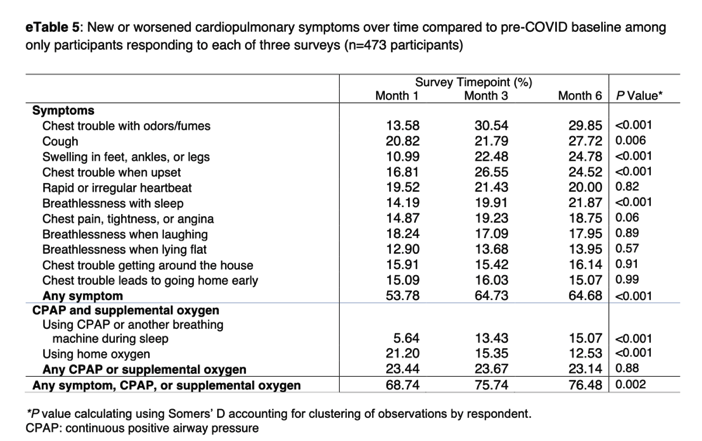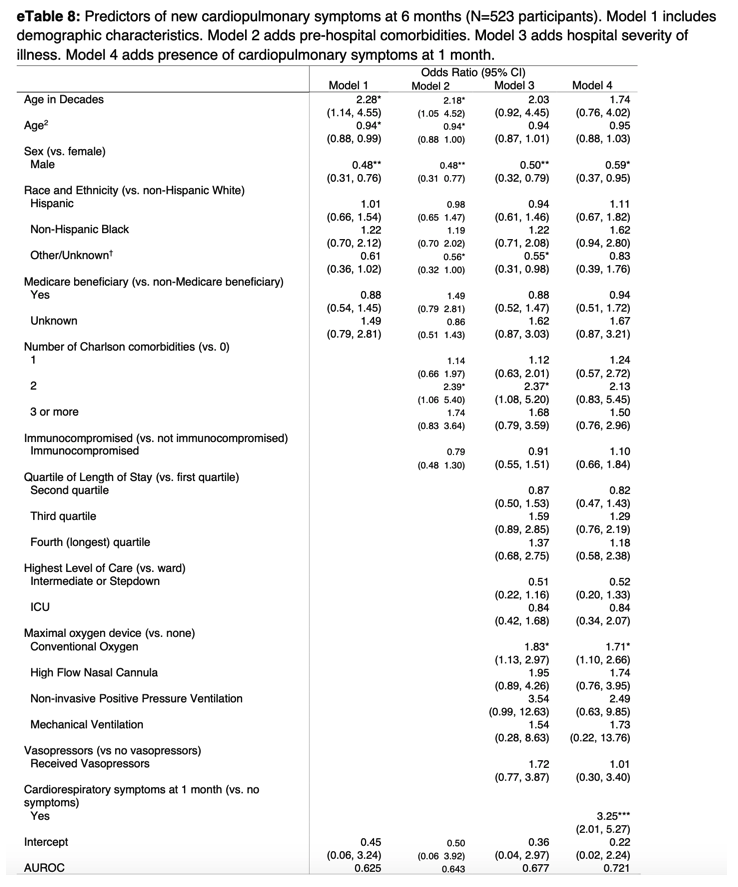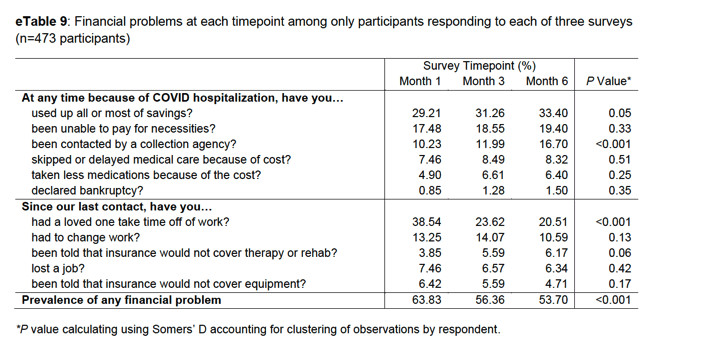| |
Lingering symptoms common after COVID hospitalization
|
| |
| |
Download the PDF here
Download the PDF here
Many adults experience problems like coughing, chest pain, and fatigue six months after their stay.
Publication
These findings suggest the need for health care systems, clinicians, and patients to recognize and manage both persistent and new problems after COVID-19-related hospitalization.
"these findings suggest a possible disconnect between the known predictors of initial COVID-19 severity and those of long-term recovery in some health domains."
see Tables below - all top often Non-Hispanic Blacks & Hispanic had higher rates of lingering heath affects & financial insecurities.
For many individuals, the effects of COVID-19 persist after the acute phase and result in prolonged symptoms and disability.1,2
While some individuals who survived COVID-19 experienced improvements in early posthospitalization symptoms and disability, many continued to experience cardiopulmonary, financial, and functional problems 6 months after discharge. These findings suggest the need for health care systems, clinicians, and patients to recognize and manage both persistent and new problems after COVID-19-related hospitalization.
Our findings are suggestive of prolonged sequelae that are inconsistently related to initial acuity. In line with this, a study comprising predominately outpatients with COVID-19 in Washington revealed persistent symptoms in 30% and functional impairment in 8% at a median of 6 months.28 A UK-based follow-up study of 1077 patients with COVID-19 hospitalized in wards and intensive care units revealed that fewer than 1 in 3 participants had recovered completely after a median 5.9 months.1 Together, these findings suggest a possible disconnect between the known predictors of initial COVID-19 severity and those of long-term recovery in some health domains. Alternatively, they may reflect variability in the trajectories experienced by survivors of COVID-19 owing to individual responses to treatment or differences in either inpatient or posthospital care.29,30
We found that the proportion of participants reporting cardiopulmonary symptoms increased between months 1 and 6, while the proportion of participants reporting a new ADL or IADL impairment decreased
Job loss, savings depletion, and forgone care occurred most often in the first month after COVID-19; yet, new bankruptcies, collection agency calls, and job changes continued to occur at 6 months and were reported more often among minoritized populations.
-------------------------------------
Tuesday, February 14, 2023
NIH press release
About half of adults treated at hospitals for COVID-19 have experienced lingering symptoms, financial difficulties, or physical limitations months after being discharged, according to a National Institutes of Health-supported study published in JAMA Network Open.
After six months, more than 7 in 10 adults surveyed in the study experienced cardiopulmonary problems, such as coughing, rapid or irregular heartbeat, and breathlessness, while about half had fatigue or physical limitations - all symptoms associated with long COVID(link is external). Additionally, more than half of the adults said they faced financial challenges.
The findings came from the PETAL Network's Biology and Longitudinal Epidemiology: COVID-19 Observational (BLUE CORAL(link is external)) study, which is supported by the National Heart, Lung, and Blood Institute (NHLBI), part of NIH.
"My clinic patients often want to know how soon they'll get back to their usual health," said Andrew J. Admon, M.D., M.P.H., the study's first author, a pulmonologist at LTC Charles S. Kettles VA Medical Center, and an assistant professor in the departments of internal medicine and epidemiology at the University of Michigan, Ann Arbor. "Based on these data, it seems that many people hospitalized for COVID-19 should expect symptoms to last for up to six months or even longer."
To conduct the analysis, researchers assessed data from the medical records and follow-up surveys of 825 adults who received treatment for COVID at one of 44 medical centers in the United States between August 2020 and July 2021. Patients were surveyed one, three, and six months after leaving the hospital for general or intensive care treatment.
The researchers found that six months after being hospitalized:
• Three-fourths of patients, 75%, had at least one cardiopulmonary problem, such as cough or chest problems; swelling in their legs, ankles, and feet; or a need for home oxygen support. This represented an increase from the first month, when 67% of patients reported experiencing problems like these.
• More than half of patients, 51%, felt fatigued compared to 41% who did so after one month. Almost one in five adults, 18%, felt tired every day
• More than half of patients, 56%, experienced a financial difficulty such as being unable to pay bills, compared to 66% who had problems after one month. Hispanic and Black participants, as well as participants who reported financial difficulty at one month, were more likely to have experienced financial challenges during the sixth month.
• Some 47% of patients reported limitations doing everyday activities, such as eating, preparing meals, bathing, getting dressed, or walking across a room, which represented an improvement compared to the first month, when 55% of patients experienced such limitations.
• Symptoms came and went for some patients, creating intervals of recovery. For instance, some adults were free of symptoms after one month but developed symptoms such as heart and chest problems later.
"These findings will inform programs designed to help adults recover from severe cases of COVID and guide how physicians should check in with patients in the year following hospitalization," said James P. Kiley, Ph.D., the director of NHLBI's Division of Lung Diseases. "They may also help shape future clinical research studies."
For a bigger picture, other studies, such as the Household Pulse Survey, have suggested that half of U.S. adults(link is external) have reported having COVID. International data(link is external) suggest that about 1 in 13 adults, 6-7%, who have had symptomatic COVID infections still experienced symptoms months later. Based on research published in JAMA(link is external), symptoms lasted for about four months for those who recovered outside of the hospital compared to nine months for those who received hospital care.




|
|
| |
| |
|
|
|